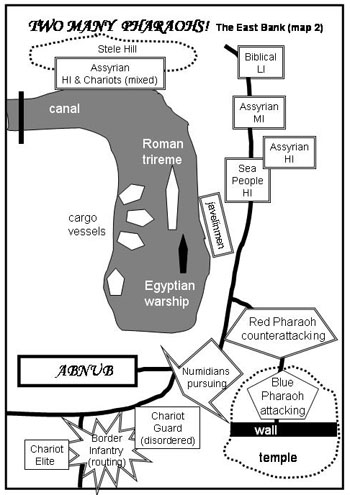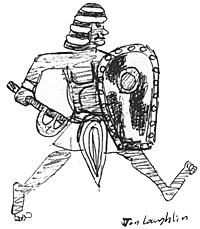Part 1 [LW142]
Part 2 [LW143]
Part 3 [LW144]
Part 4 [LW145]
Part 5 [LW146]
 Wargaming Note:
Wargaming Note:
It can be seen by looking at Map #1 [parts I through V] that about one third of the table was no longer being used by troops and therefore was redundant. Accordingly I rolled the terrain along, until I had a table, which was ready for the introduction of some combatants. I simply took the 2’ x 2’ terrain tiles off the northern (enemy) end of the table, pushed the remaining tiles carefully in a wargaming northerly direction and added terrain tiles to the southern end, ready for the battle to develop. This is ‘Mobile Terrain’, an idea acquired from Lone Warrior.
Game:
With the two pharaohs about to engage ‘man to man’ at the base of Temple Hill; screaming Numidians attacking the somewhat disorder charioteers to the south of Abnub; the 4 Horse Chariots on the west bank just about to ride down the shattered Blue Elite infantry regiment, there were still a lot of units from both side not accounted for.
In the north, on the eastern bank there was a confused mass of units trying to get along the quay to help the Red Pharaoh in his direct attempt to kill the Blue Pharaoh. The heavy infantry, both Assyrian and Sea Peoples refusing to give way, did not help the bottleneck and nearly coming to blows over priority of passage. The Assyrian mediums joined in to help their fellow countrymen, making the confusion even greater and the Bibilical light infantrymen just got pushed out of the way.
However, the javelinmen had managed to get through the gap before the congestion started and were moving towards the temple when they came under desultory archery fire from the vessels in the canal. Acting out of instinct the javelins flew towards the anchored vessels and then it really got hot on the quayside. The Romans let fly with everything they had from ballista bolts, arrows, javelins and quite a few choice rather unsavoury Latin comments – because when it came down to it, they were not really involved in the Egyptian local wars. The few Egyptian marines on the coastal vessel had fired off a few arrows at the Red missile men, who in return had just thrown their javelins at all and any ship, thereby bringing the trireme into the conflict.
Wargaming note:
Trying to justify the involvement of the Romans by using an historical precedence but can’t just quite think of one at present! Any assistance with this problem will be gratefully received. It’s a conscience thing. It should also be noted that this incident occurred long before the naval reinforcements arrived and OK, I admit it I really wanted a bit of help on that part of the table! I put it down to one of the few perks of being a soloist.
Game:
On the west bank, along the riverside the 4 Horse Chariots and their supporting infantry had stopped just short of the Gates of Horus because the terrain was too difficult to cross in the dark. With the coming of the dawn the units began to slowly move towards Abnub, which compared with both riverbanks appeared extremely quiet.
To the south of Abnub the Blue Pharaoh’s Elite Charioteers had reacted with the experience of their years and quickly harnessed their steeds and moved into a defensive posture until they could ascertain what exactly was going on around the city.
Map 2 – East Bank; shows in a clinical manner the confusion that was reigning within that area. Archers from the walls of Abnub had began to inflict serious casualties on the battle-crazed Numidians but failed to halt their mad charge into the Guard Charioteers. Despite the inability of the mounted warriors to build up any momentum to counter charge and in reality being mobile missile troops, the Blue Pharaohs guardsmen gave a really good account of themselves in the ensuing melee. The terrified antics of the horses and the accuracy of the arrows cut swathes through the unarmoured Numidians, who soon broke and ran from the conflict. In order to escape from the chariots the infantrymen scaled the causeway and fled into the plain beyond, all the while being harassed by archery from the walled city.
Things were not looking promising for the Red soldiers but luck was at hand in the form of a stray arrow which wounded the sailor steering the large Egyptian corn carrying vessel, for the western shore of the canal. Letting go of his steering oar, his ship collided with the coastal patrol ship, which in turn got entangled with the Roman triremes stern. The coastal vessel slew slowly towards the quay and nothing could be done because within minutes all the sailors and marines on board were either dead or seriously wounded from the javelins, thrown with increasing accuracy at the decreasing distance between boat and land.
Roman marines cut and pushed away the stricken Egyptian ship, just in time, as a swarm of Red Javelinmen clambered aboard the captured craft. The cargo vessel had also managed to disentangle itself and had made for the far side of the canal, under the banks and walls of Abnub.
The trireme got under way and moved up the canal, away from the drifting coastal craft with its ‘crew’ of landlubbers, until it was able to manoeuvre to protect its merchant craft charges and re-engage with the red forces. The restrictions of space within the canal basin were of a great concern to the Triremes captain and although he did not know it he and his fleet were actually trapped.
The combat between the two Pharaohs was intense, bloody and a stalemate, in that neither could break the other. After a few minutes of hectic combat the Red Pharaoh realised he would lose his chariots if he remained in the confining space of the Temple Hill and pulled back his men towards the mixed mess that was his advancing heavy infantry. There was no pursuit from the Blues because they were too exhausted to do so.
 Wargaming note:
Wargaming note:
It is a personal preference to actually play a game where the terrain plays an important part in what actually goes on and I decline to have a battle on a billiard/pool table. The restrictions for the warship, was actually noticeable with the size of the models and the water they could manoeuvre in. The need for the red charioteers to withdraw was based on the tactics of the time, in that the chariots were missile biased rather than shock/attack vehicles.
You are probably wondering [or not], how the ships came to collide. It was quite easy in that there were 3 ships within range of the javelinmen, the coastal ship and the trireme were prime targets and using a D10 I was able to decide which ship got hit; 1 – 5 Coastal ship being closer; 6 – 9 the Trireme and finally 10 meant the slow moving, large merchant ship. Working on the principle that there would be two exposed sailors on the merchant man, namely the captain and the guy doing the steering – having studied films, pictures and looked at the models – I instantly decided once the ship had taken a hit that the pilot would bite the dust. Rationale being; Captain hit possibly crew upset, but pilot hit then the ship moves out of control. Fling in a few collision rules from my Ancient Galley rulebooks [yes, I use more than one] and chaos ruled. Great fun and gave an added dimension to the game.
Next edition: The West Bank erupts! [Writing this up is like replaying the game, only I know the outcome this time!]
More Chariot Saga
Back to Table of Contents -- Lone Warrior # 147
Back to Lone Warrior List of Issues
Back to MagWeb Magazine List
© Copyright 2004 by Solo Wargamers Association.
This article appears in MagWeb.com (Magazine Web) on the Internet World Wide Web.
Other articles from military history and related magazines are available at http://www.magweb.com
